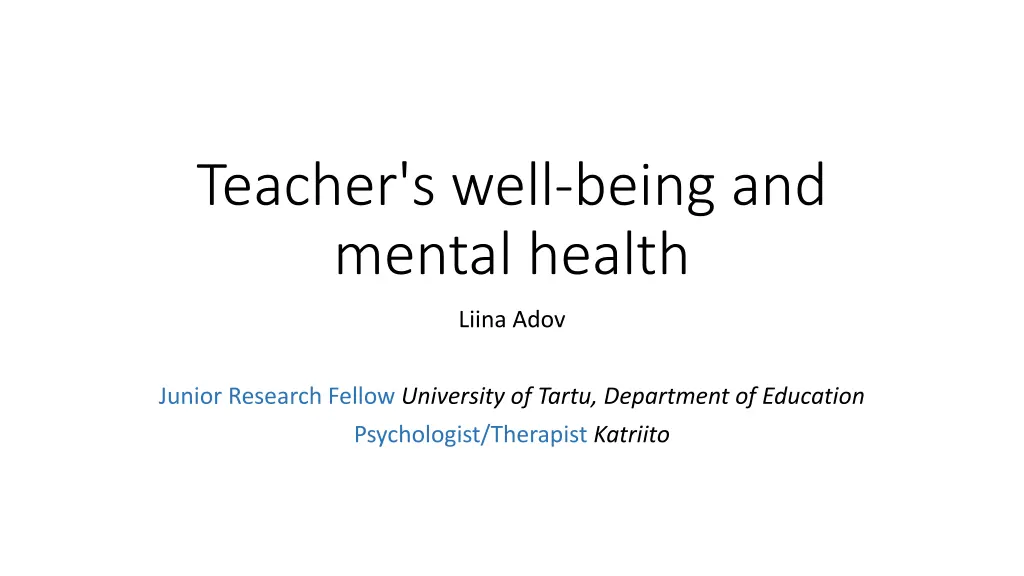
Supporting Teacher Well-Being in Education
Discover the importance of teacher well-being and mental health in education, as highlighted through research and professional standards in Estonia. Explore the risks faced by teachers and their impact on students, emphasizing the need for support and awareness in the education sector.
Download Presentation

Please find below an Image/Link to download the presentation.
The content on the website is provided AS IS for your information and personal use only. It may not be sold, licensed, or shared on other websites without obtaining consent from the author. If you encounter any issues during the download, it is possible that the publisher has removed the file from their server.
You are allowed to download the files provided on this website for personal or commercial use, subject to the condition that they are used lawfully. All files are the property of their respective owners.
The content on the website is provided AS IS for your information and personal use only. It may not be sold, licensed, or shared on other websites without obtaining consent from the author.
E N D
Presentation Transcript
Teacher's well-being and mental health Liina Adov Junior Research Fellow University of Tartu, Department of Education Psychologist/Therapist Katriito
Teachers professional standards by Estonian Qualifications Authority - B.2.4 Reflection and professional self-development 3) monitors, evaluates, and values ones physical, mental, and emotional health, takes action in keeping the balance between these, optimizes the time and energy expenditure ..
Elective course for student teachers Teachers physical, mental, and emotional health and balance between these
In Estonia we dont speak much about teachers stress and burnout, however, the presence of burnt out teachers in every school, shows us that this matter hasn t got enough attention from the government. K rt K sel Association of Estonian School Psychologists
Teachers as high risk group Low controll Emotional demandingness Work with people UK example - 19,4% moderate to severe depression symptoms Australian example - 26% high risk group for psychological problems Garrick, A., Winwood, P. C., Mak, A. S., Cathcart, S., Bakker, A. B., & Lushington, K. (2014). Prevalence and organisational factors of psychological injury among Australian school teachers. Australasian Journal of Organisational Psychology, 7. https://doi.org/10.1017/orp.2014.5 Kidger, J., Brockman, R., Tilling, K., Campbell, R., Ford, T., Araya, R., Gunnell, D. (2016). Teachers wellbeing and depressive symptoms, and associated risk factors: A large cross sectional study in English secondary schools. Journal of Affective Disorders, 192, 76 82. https://doi.org/10.1016/j.jad.2015.11.054 Wieclaw, J., Agerbo, E., Mortensen, P. B., Burr, H., Tuchsen, F., & Bonde, J. P. (2008). Psychosocial working conditions and the risk of depression and anxiety disorders in the Danish workforce. BMC Public Health, 8, 280-288.
Teachers influence on students Kinman, Wray, & Strange (2011) bring out that teachers who reported more emotional labour were not only more emotionally exhausted and less satisfied with their work, they were also more likely to depersonalise their pupils. Kinman, G., Wray, S., & Strange, C. (2011). Emotional labour, burnout and job satisfaction in UK teachers: The role of workplace social support.Educational Psychology, 31(7), 843-856.
Motivation Autonomy, relatedness, precieved competence, self- efficacy Job satisfaction Experience with covision and supervision Indicators of mental health (anxiety, sleep deprivation etc.) Stress management Burnout Preceived stress
Data collection Emotional State Questionnaire (EEK-2; pik, Aluoja, Kalda, & Maaroos, 2006; Aluoja, Shlik, Vasar, Luuk, & Leinsalu, 1999) Teachers Sense of Efficacy Scale (Tschannen-Moran & Hoy, 2001) The Basic Need Satisfaction at Work Scale (Deci, Ryan, Gagn , Leone, Usunov, & Kornazheva, 2001; Ilardi, Leone, Kasser, & Ryan, 1993; Kasser, Davey, & Ryan, 1992). Job satisfaction (Caprara, Barbaranelli, Borgogni, & Steca, 2003) Perceived Stress Scale (Kallasmaa & Pulver, 2000) Coping with Stress (Carver, C. S., 1997)
Longitudinal study 1st wave March/Aprill 2017 All schools in Estonia 2nd wave November 2017 All schools + teachers from 1st wave 3rd wave March 2017 Teachers from 1st and 2nd wave
Preliminary results 1st wave 2nd wave 329 teachers 236 teachers 1/3 of teachers > anxiety and depression symptoms 66% Asthenia 36 40% anxiety/dep. sym. 38% problems with sleep stress = anxiety/dep.sym. self-efficacy = anxiety/dep. Formal covision(peer group mentoring) - anxiety/dep
Thank you! Ait h! Hvala! liina.adov@ut.ee
